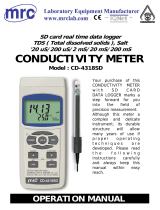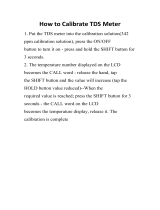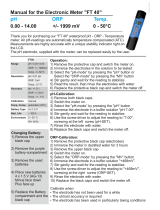Page is loading ...

pH, ORP, CD, TDS, DO, SALT
METER
Model : YK-2001PHA
Your purchase of this
pH, ORP, CD, TDS, DO,
SALT METER marks a
step forward for you
into the field of
precision measurement.
Although this meter a
complex and delicate
instrument, its durable
structure will allow
many years of use if
proper operating
techniques are
developed. Please read
the following
instructions carefully
and always keep this
manual within easy
reach.
OPERATION MANUAL

TABLE OF CONTENTS
1. FEATURES..............................................................................................................
1
2. SPECIFICATIONS........................................................................................................
3
2-1 General Specifications................................................................................................
3
2-2 Electrical Specifications.........................................................................
5
3. FRONT PANEL DESCRIPTION...........................................................................
10
4. FUNCTION SELECTION.......................................................................................
12
5. PH/mV MEASURING and CALIBRATION
PROCEDURE....................................................................................................
13
6. CONDUCTIVITY/TDS MEASURING and
CALIBRATION PROCEDURE...................................................................................
19
7. SALT MEASURING and calibration PROCEDURE............................................................
23
8. DO ( Dissolved Oxygen ) MEASURING
and CALIBRATION PROCEDURE...................................................................................
25
9. OTHER FUNCTION....................................................................................................
31
9-1 Data Hold.........................................................................................................................
31
9-2 Record ( Max./ Min. reading )....................................................................
31
9-3 LCD Backlight ON/OFF....................................................................................................
32
10. ADVANCED SETTING...............................................................................
32
11. POWER SUPPLY from DC ADAPTER.....................................................
37
12. BATTERY REPLACEMENT.............................................................................................
37
13. SYSTEM RESET.................................................................................................................
37
14. RS232 PC SERIAL INTERFACE.....................................................................................
38
15. OPTIONAL ACCESSORIES.........................................................................................
39

1. FEATURES
* One meter for multi purpose operation :
PH/ORP, CD/TDS, Dissolved Oxygen, Salt measurement.
* pH : 0 to 14.00 pH, ORP : ±1999 mV.
* Conductivity : 200 uS/2 mS/20 mS/200 mS.
* Dissolved oxygen : 0 to 20.0 mg/L.
*
Salt : 0 to 12 % salt ( % weight ).
* Optional PH, ORP, CD/TDS/Salt, Dissolved Oxygen and
ATC probe.
* PH meter function can select PH or ORP.
* PH measurement can select ATC or manual temperature
adjustment.
* PH measurement can make the auto calibration for
pH 7, pH 4 and pH 10 or other value.
* Conductivity measurement can select uS/mS or TDS
* Conductivity measurement can select Temp. Coefficient
of measurement solution.
* ATC for the conductivity measurement.
* Dissolved oxygen meter use the polar graphic type
oxygen probe with temperature sensor, high precision
measurement for Dissolved Oxygen ( DO ) and
temperature measurement.
* Heavy duty dissolved oxygen probe, probe head can
connect with BOD bottle.
* DO use the automatic Temp. compensation.
* DO meter build in " % SALT " & " Mountain Height "
compensation value adjustment.
* Separate probe, easy for operation of different
measurement environment.
1

* Wide applications: water conditioning, aquariums,
beverage, fish hatcheries, food processing,
photography, laboratory, paper industry, plating
industry, quality control, school & college, water
conditioning.
* LCD with green light backlight, easy reading.
* Can default auto power off or manual power off.
* Data hold, record max. and min. reading.
* Microcomputer circuit, high accuracy.
* Power by DC 9 V (006 P) batteries or DC 9V adapter.
* RS232/USB PC COMPUTER interface.
2

2. SPECIFICATIONS
2-1 General Specifications
Circuit
Custom one-chip of microprocessor LSI
circuit.
Display LCD size : 52 mm x 38 mm
LCD with green backlight ( ON/OFF ).
Measurement PH/ORP
Function Conductivity/TDS(Total Dissolved Solids)
Dissolved Oxygen
Salt
Advanced
* Auto power OFF management
setting
*
Set beep Sound ON/OFF
*
Set temperature unit to ℃ or ℉
* Set DO salt% compensation value
* Set DO height ( meter ) compensation value
* Set DO height ( feet ) compensation value
* Set CD temperature compensation factor
* Set CD to TDS or TDS to CD, CD only
* Set pH manual Temp. compensation value
Data Hold Freeze the display reading.
Memory Recall Maximum & Minimum value.
`
3

Sampling Time Approx. 1 second.
of Display
Data Output
RS 232/USB PC computer interface.
* Connect the optional RS232 cable
UPCB-02 will get the RS232 plug.
* Connect the optional USB cable
USB-01 will get the USB plug.
Operating 0 to 50 ℃.
Temperature
Operating Less than 85% R.H.
Humidity
Power Supply Alkaline or heavy duty DC 9 V (006 P)
battery or equivalent.
DC 9V adapter input. ( AC/DC power
adapter is optional ).
Power Current
Normal operation ( LCD Backlight is OFF) :
Approx. DC 14 mA.
*
If LCD backlight on, the power
consumption will increase approx.
12 mA.
Weight 489 g/1.08 LB.
Dimension 177 x 68 x 45 mm
(7.0 x 2.7x 1.9 inch)
Accessories *
Instruction manual..............................................................
1 PC
Included
* Conductivity/TDS probe,
Salt probe.......CDPB-03.......................................................
1 PC
4

Optional
*
PH electrode.......................
Accessories PE-03, PE-11, PE-01, PE06HD
PE-04HD, PE-05T, PE-03K7
* ATC probe ( Automatic Temperature
Probe )........................................ TP-07
* pH 7 buffer solution................. PH-07
* pH 4 buffer solution..................... PH-04
*
Pt Conductivity probe......................................
CDPB-04
* 1.413 mS Conductivity Standard
Solution................................ CD-14
*
Oxygen probe..........................................
OXPB-11
* Spare Probe head with Diaphragm set
.........................................................
OXHD-04
*
Probe-filling Electrolyte....................
OXEL-03
* ORP Electrode........................... ORP-14
AC to DC 9V adapter.
USB cable, USB-01.
RS232 cable, UPCB-02.
Data Acquisition software,SW-U801-WIN.
Hard carrying case ( CA-06 )..................................
1 PC
2-2 Electrical Specifications (23±5
℃
)
A. PH/mV
PH
Optional,
Electrode
Any PH electrode with BNC connector.
Measurement PH 0 to 14 PH
mV
-1999 mV to 1999 mV
Input 10^12 ohm
Impedance
5

Temperature Manual 0 to 100 ℃, be adjusted by
Compensation push button on front panel.
for pH
Automatic
With the optional temperature
measurement ( ATC ) probe ( TP-07 )
0 to 65 ℃.
pH PH7, PH4, and PH10, 3 points calibration
Calibration ensure the best linearity and accuracy.
Optional *
PH electrode.......................
PE-03, PE-11, PE-01, PE06HD
probe and
PE-04HD, PE-05T, PE-03K7
accessories * ATC ( automatic temperature
probe )....................................... TP-07
* pH 7 buffer solution.....................
PH-07
* pH 4 buffer solution......................
PH-04
* ORP electrode.............................. ORP-14
Measurement Range Resolution Accuracy
PH 0 to 14 PH 0.01 PH ±(0.02 PH + 2 d)
mV
-1999 to 1999 mV 1 mV
±(0.5% + 2 d)
* PH accuracy is based on calibrated meter only.
B. Conductivity
Conductivity probe Optional, Carbon rod electrode for long life.
Function * Conductivity ( uS, mS )
* TDS ( Total Dissolved Solids, PPM )
* Temperature ( ℃,℉)
Temperature
Automatic from 0 to 60 ℃ (32 - 140 ℉),
Compensation with temperature compensation factor
variable between 0 to 5.0% per C.
Probe 0 to 60 ℃.
Operating Temp.
Probe Dimension Round, 22 mm Dia. x 120 mm length.
Optional *
Conductivity probe......................................
CDPB-03
probe and *
Pt Conductivity probe......................................
CDPB-04
accessories * 1.413 mS Conductivity Standard
Solution...........................................
CD-14
6

1. Conductivity ( uS, mS )
Range Measurement Resolution Accuracy
200 uS
0 to 200.0 uS
0.1 uS
2 mS 0.2 to 2.000 mS 0.001 mS ±(2% F.S.+1d)
20 mS
2 to 20.00 mS 0.01 mS * F.S. -
200 mS 20 to 200.0 mS 0.1 mS full scale
* Temperature Compensation :
Automatic from 0 to 60
℃
( 32 - 140
℉
), with temperature
compensation factor variable between 0 to 5.0% per C.
* The accuracy is specified under measurement value
≦
100 mS.
* mS - milli Simens * @ 23±5
℃
2. TDS ( Total Dissolved Solids )
Range Measurement Resolution Accuracy
200 PPM 0 to 132 PPM 0.1 PPM
2,000 PPM 132 to 1,320 PPM 1 PPM ±(2% F.S.+1d)
20,000 PPM 1,320 to 13,200 PPM 10 PPM * F.S. -
200,000 PPM 13,200 to 132,000 PPM 100 PPM full scale
* Temperature Compensation :
Automatic from 0 to 60
℃
( 32 - 140
℉
), with temperature
compensation factor variable between 0 to 5.0% per
℃
.
* The accuracy is specified under measurement value
≦
66,000 PPM.
* PPM - parts per million * @ 23±5
℃
3. Temperature
Function Measuring Range Resolution Accuracy
℃ 0 ℃ to 60 ℃ 0.1 ℃ ±0.8 ℃
℉ 32 ℉ to 140 ℉ 0.1 ℉ ±1.5 ℉
* @ 23±5
℃
7

C. Salt
Conductivity Optional,
probe Carbon rod electrode for long life.
Measurement 0 to 12 % salt ( % weight ).
Range
Resolution 0.01 % salt.
Accuracy 0.5 % salt value
* F.S. : full scale.
Temperature
Automatic from 0 to 60 ℃ (32 - 140 ℉),
Compensation with temperature compensation factor
variable between 0 to 5.0% per C.
Probe 0 to 60 ℃.
Operating
Temperature
Probe Round, 22 mm Dia. x 120 mm length.
Dimension
Optional
probe and *
Pt Conductivity probe......................................
CDPB-04
accessories
8

D. Dissolved oxygen
Oxygen
Optional, OXPB-11
Probe The polarographic type oxygen probe with
Measurement Dissolved Oxygen 0 to 20.0 mg/L ( liter ).
& Range Oxygen in Air 0 to 100.0 %.
Temperature
0 to 50 ℃.
Resolution Dissolved Oxygen 0.1 mg/L.
Oxygen in Air 0.1 % O2 .
Temperature
0.1 ℃.
Accuracy Dissolved Oxygen ±0.4 mg/L.
(23±5 ℃) Oxygen in Air ±0.7% O2.
Temperature
±0.8 ℃/1.5 ℉.
Probe Temperature 0 to 50 ℃,
Compensation
Automatic
& Adj. Salt 0 to 50 % Salt
Height ( M. T.) 0 to 8900 meter
Probe Weight 335 g/0.74 LB
( batteries & probe included )
Probe Size 190 mm x 28 mm Dia. ( 7.5" x 1.1" Dia. )
Optional * Oxygen probe.......................................... OXPB-11
Accessories * Spare Probe head with Diaphragm set
......................................................... OXHD-04
* Probe-filling Electrolyte.................... OXEL-03
@ Above specification tests under the environment RF Field Strength
less than 3 V/M & frequency less than 30 MHz only.
9

3. FRONT PANEL DESCRIPTION
Fig.1
10

3-1 Display
3-2 Power Button ( Backlight Button )
3-3 Hold Button ( ESC Button )
3-4 REC Button
3-5 ▲ Button ( Range Button)
3-6 ▼ Button (Function Button )
3-7 Set Button
3-8 Enter Button
3-9 Stand
3-10 Battery Compartment/Cover
3-11 Battery Cover Screw
3-12 Tripod Fix Nut
3-13 Temp. Socket ( PH ATC Socket )
3-14 DO Socket
3-15 CD Socket
3-16 PH Socket ( BNC Socket )
3-17 DC 9V Power Adapter Input Socket
3-18 Reset Button
3-19 RS-232 Output Terminal
11

4. FUNCTION SELECTION
1) Turn on the meter by pressing the " Power Button "
( 3-2, Fig. 1 ) momentarily.
*
Pressing the " Power Button " ( 3-2, Fig. 1 )
continuously and > 2 seconds again will turn off the
meter.
2) The meter can select 7 kind Function as :
a. pH measurement
b. mV ( ORP ) measurement
c. Dissolved Oxygen measurement
d. Air Oxygen measurement
e.
Conductivity measurement
f.
TDS measurement
g. Salt measurement
Use the " Function Button " ( 3-6, Fig. 1 ) Key to select intent test
function. Display will show the following text in sequence :
PH
pH measurement
OrP
mV ( ORP ) measurement
do
Dissolved Oxygen measurement
O2 Air Oxygen measurement
Cd
Conductivity measurement
tdS
TDS measurement
SALt Salt measurement
Until the Display show the desired mode the meter will
execute this Function with default.
12

5. PH/mV MEASURING and
CALIBRATION PROCEDURE
The meter default function are following :
* The display unit is set to pH.
* The temperature unit is set to ℃.
* Manual ATC ( without connect the ATC probe )
* Auto power off.
If the meter is first time to connect
the pH electrode, it should make the
calibration before operation, the
calibration procedures refer to
chapter 5-4, page 15.
13

5-1 pH measurement ( manual Temp. compensation )
1) Power on the meter by pressing " Power Button "
( 3-2, Fig. 1 ) once.
Use the " Function Button " ( 3-6, Fig. 1 ) Key, select to
pH measurement Function.
refer to Chapter 4, page 12.
2) Prepare the pH Electrode ( optional ), install the
" Probe Plug " ( 5-1, Fig. 2 ) into the " PH Socket/BNC
Socket " ( 3-16, Fig. 1 ).
3)
Adjust the manual Temp. value same as the
solution's temperature exactly, the procedures
refer chapter 10-8, page 37.
4) Hold the " Electrode Handle " ( 5-2, Fig. 2 ) by hand
and let the " Sensing head " ( 5-3, Fig. 2 ) immersed
wholly into the measured solution and little shake the
electrode.
5) The main display will show the pH value, the
bottom display will show the setting manual Temp.
value.
5-2 PH measurement ( ATC , automatic Temperature )
1) All the procedures are same as
5-1 PH measurement ( manual Temp. compensation)
but should prepare one temperature probe ( optional,
TP-07 ), insert the TP-07's plug into the " Temp. Socket "
( 3-13, Fig. 1 ), immerse the sensing head of temperature
probe ( TP-07 ) into the measurement solution.
2) The main display will show the pH value, the bottom
display will show the sensing Temp. value of the
measured solution ( measured from ATC probe, TP-07 ).
14

When not use the Electrode, it should immerse
the " Electrode sensing head " ( 5-3, Fig. 2 ) into
the " Protection bottle " ( 5-4, Fig. 2 )
5-3 mV Measurement
The instrument build in mV ( millivolt ) measurement
function, which enable you to make ion-selective, ORP
(oxidation-reduction potential), and other precise mV
measurements.
1) Use the " Function Button " ( 3-6, Fig. 1 ) Key, select to
mV ( ORP ) measurement Function.
the Display unit will show " mV "
2) Prepare the ORP Electrode ( optional, ORP-14 ), install
the " Probe Plug " of ORP electrode into the " PH
Socket/BNC Socket " ( 3-16, Fig. 1 ).
3) The Display will show the mV value.
5-4 pH calibration
Calibration Consideration
The most ideal pH ELECTRODE generates 0 mV at pH
7.00 ( 177.4 mV at PH 4 ) and meter has been always
calibrated with signals which simulate the most ideal pH
ELECTRODE ( based on 25 ℃ ambient environment ).
However not every pH ELECTRODE is as accurate as the
most ideal one, so calibration procedures are necessary
to be done before the first time measurement.
In addition to the first time measurement, users are also
recommended to execute the calibration procedures to
ensure the high accuracy measurement.
15

Required Equipment for Calibration
1) pH ELECTRODE ( optional ).
2) pH buffer solutions ( optional ).
Calibration Procedure
1) Prepare the pH Electrode ( optional ), install the
" Probe Plug " ( 5-1, Fig. 2 ) into the " PH Socket/BNC
Socket " ( 3-16, Fig. 1 ).
2) Power on the meter by pressing " Power Button "
( 3-2, Fig. 1 ) once.
Select the Meter's measurement Function to " PH ".
3) Adjust the " Temperature Compensation Value " to
make it same as the temperature value of the pH
buffer solution.
* Manual temperature compensation value
adjustment procedure, refer to 10-8, page 36.
* Automatic temperature compensation, it
should plug in the ATC probe ( optional, TP-07 ).
.
4) Hold the " Electrode Handle " ( 5-2, Fig. 2 ) by hand
and let the " Sensing head " ( 5-3, Fig. 2 ) immersed
wholly into the measured solution and little shake the
probe. Display will show the PH value.
*
If use the ATC probe, should imerse the
ATC ptobe into the solution together.
16

5)
Use the two fingers to press the " ▲ Button " ( 3-5,
Fig 1 ) and " ▼ Button " ( 3-6, Fig. 1 ) at the
same time. Until Display will show the following screen
then release the both fingers.
PH
CAL
6)
Press the " ▲ Button " ( 3-5, Fig. 1 ) or " ▼ Button "
( 3-6, Fig. 1 ) once in sequence to select the following
screen.
a For pH 4.00 calibration
4.00
CAL
b For pH 7.00 calibration
7.00
CAL
c For pH 10.00 calibration
10.00
CAL
d Clear the existing calibration data
CLr
CAL
17

* After the above a, b, c screen is selected, then cooperate
the relative standard solution, for example the
b screen should cooperate the pH 7.00 standard solution.
a screen should cooperate the pH 4.00 standard solution.
Press the " Enter Button " ( 3-8, Fig. 1 ) will
save the calibration data and finish the calibration
procedures.
* If select the d screen, press the " Enter Button " (
3-8, Fig. 1 ) will clear existing calibration data.
7) The complete procedures should execute
the two calibration points :
PH7 calibration
PH4 calibration ( or PH10 calibration )
* The calibration procedures should execute start from
pH7 calibration then follow pH4 ( or pH10 ) calibration.
* Rinse the electrode with distilled water again when
make each point calibration ( pH7, pH4 or pH10 ).
* Repeat above two points procedures two times at least.
18
/












